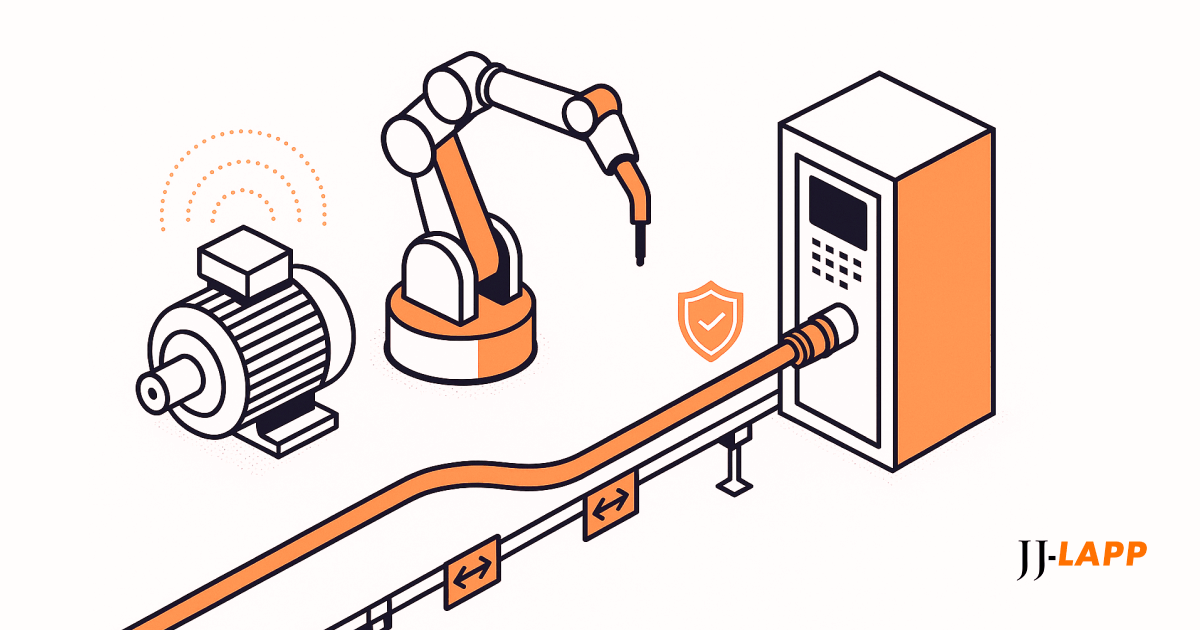When a 250 kW motor roars to life, its electromagnetic buzz can knock sensors offline in a heartbeat. Welding guns, VFD‑driven motors, and robot arms flood the air with interference that chews through unshielded data lines. For the engineers and IT/OT teams who keep those lines alive, rock‑solid communication is the difference between smooth production and an expensive standstill.
Let’s break down why shielding matters—and how to pick the right cable the first time.
Understanding EMI & Its Real-World Impact
Electromagnetic interference (EMI) is unwanted electrical noise disrupting signal transmission. In factories, common EMI sources include variable frequency drives (VFDs), industrial motors, welding machines, servo controls, and high-voltage transformers. All these devices emit electromagnetic fields that can corrupt data signals, causing intermittent errors, false sensor readings, and unplanned machine stops.
According to Frost & Sullivan’s 2024 Industrial Downtime Benchmarking study, the median cost of EMI‑related outages in ASEAN factories is about US$2.5 million per hour—32 % above the global average. That’s the price of a brand‑new CNC machine, lost every 60 minutes. This highlights the urgency of addressing EMI effectively.
For industries that run on tightly synchronized automation—think automotive welding lines, electronics pick‑and‑place robots, or fully networked ‘smart’ factories—even a millisecond data glitch is like a missed heartbeat in a pacemaker: small but potentially fatal, setting off cascading failures down the line. The result? Production delays, expensive troubleshooting, wasted materials, and significant financial losses.
Explore more on Industrial Communication Ethernet here.
How Shielded Data Cables Combat Interference
Shielded cables provide a protective barrier around signal-carrying conductors, dramatically reducing vulnerability to EMI. There are three primary types of shielding, each suited for specific interference scenarios:
- Foil Shielding: Consisting of an aluminum or copper foil, it offers near-total coverage (100%) and excels against high-frequency EMI. However, foil shields are less flexible and can break if repeatedly bent.
- Braided Shielding: Featuring woven copper strands, braided shielding offers 70-85% coverage and provides excellent mechanical protection, flexibility, and is effective against lower-frequency interference.
- Composite Shielding (S/FTP): Combines both foil and braid to deliver comprehensive EMI defense. This type is ideal for high-speed networks operating in EMI-dense environments, offering up to 40 dB of crosstalk suppression and maintaining data integrity even at frequencies up to 500 MHz.
Real-World Example
Fluke Networks’ DSX CableAnalyzer certification trials show that Cat.6A S/FTP links sustain 10 Gb/s data rates with NEXT margins well above 35 dB—even when subjected to aggressive radiated‑noise testing(flukenetworks.com). In parallel, LAPP’s own EMC lab results report up to 40 dB crosstalk suppression for ETHERLINE Cat.6A shielded designs compared with UTP alternatives(e.lapp.com). In plain English: shielded cables keep talking when unshielded lines fall silent.
Shielded cables command a documented 15–30 % upfront premium over unshielded options, yet most plants earn that back in a single quarter—exactly because one hour of avoided downtime dwarfs the extra cable spend. Considering the steep hourly costs of downtime, facilities consistently see a rapid ROI when adopting shielded solutions.
Which Shielded Cables Are Right for Your Facility?
Picking the right cable is a bit like choosing work boots—fit, toughness, and the hazards you face all matter. JJ-LAPP offers various industrial-grade shielded cables, each suited for specific applications:
- ETHERLINE LAN Cat.6A S/FTP: Ideal for industrial Ethernet in high-noise zones. With a robust PUR jacket, it handles harsh environments, resists UV exposure, and maintains high-speed data integrity.
- ETHERLINE Cat.6 FD: Specifically designed for dynamic applications, such as drag chains, it ensures reliable data transmission despite constant movement and mechanical stress.
- UNITRONIC LiYCY: Perfect for lower-frequency data transmission, this cable provides reliable protection against EMI in less demanding environments.
Learn more about Data Communication cables here.
Practical Steps to Implement Shielded Cables
Okay, so you’ve decided to go shielded—here’s the playbook. Follow these practical guidelines:
1. Site Assessment
Identify key EMI sources within your facility. Typical culprits include motors, welding equipment, transformers, and variable frequency drives.
2. Choosing the Correct Shield Type
- High-Frequency EMI (radio signals, electronic devices): Use foil shielding or composite (S/FTP).
- Low-Frequency EMI (motors, industrial machinery): Braided or composite shielding is recommended.
3. Grounding and Bonding
Proper grounding at both cable ends is critical. Improper grounding can significantly reduce shielding effectiveness, allowing common-mode noise to infiltrate your data channels.
4. Installation Best Practices
- Routing: Keep data cables at least 150 mm away from parallel power cables. If unavoidable, consider metal conduits or segregated cable trays.
- Cable Management: Adhere strictly to the minimum bend radius (typically 4-8 times cable diameter) to prevent shield damage, especially in flexible cable installations.
- Segregation: Clearly separate EMI-prone data lines from sensitive control signals to further reduce potential disruptions.
Explore Power & Control Cable solutions here.
Common Questions & Concerns (FAQs)
Are shielded cables significantly more expensive?
- Yes—about 15–30 % upfront.
- Why it’s worth it: One hour of avoided downtime usually pays for the upgrade many times over.
Do shielded cables require separate conduits or cable trays?
Shielding primarily addresses electromagnetic interference. Mechanical protection might still require conduits or cable trays, especially in physically harsh environments.
Can shielded cables handle harsh industrial conditions?
Absolutely. JJ-LAPP’s shielded cables typically withstand temperature extremes ranging from -40°C to +80°C, alongside excellent abrasion and chemical resistance.
Conclusion: Investing in Stability and Reliability
Reliable data transmission in EMI-rich industrial environments is critical, not optional. Shielded data cables effectively safeguard your operations against costly downtime and communication disruptions. By carefully selecting the right shielding and following proper installation guidelines, you can significantly enhance operational stability. Ready to strengthen your industrial communication networks? View JJ-LAPP’s full range of shielded cable solutions or request a technical consultation to tailor solutions to your specific EMI challenges.
